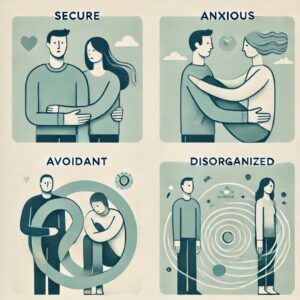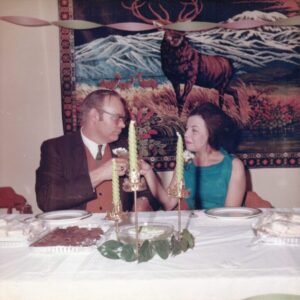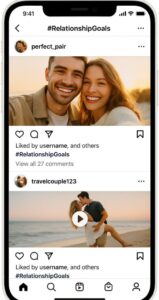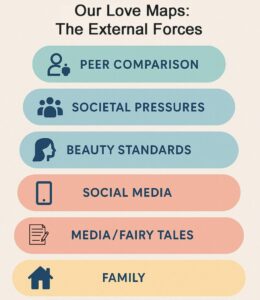- How Our Parents' Relationship Shaped Our Patterns
- The Fairy Tale Love Story Model in Pop Culture
- Fairy Tale Love in the Movies: Romantic Comedies ("Rom-Coms")
- How Fairy Tales About Love Skew Our Views
- How My Parents' Fairy Tale Courtship Clouded My Views of Love
- More External Factors Affecting Relationships: The Impact of Media on Values and Beliefs
- How Does Social Media Affect Relationships?
- Breaking Free from Societal Notions And "Being Me"
Have you considered how external factors affecting relationships — like fairy tale love stories and social media — can skew your hopes and dreams from behind the scenes?
My parents’ love story cast a long shadow. After my father died, my mother often told it to complete strangers as proof of true love (and her uniqueness). In my own quest, I felt like I had to somehow live up to that dream. Along the way, I began to believe I needed a white knight, too. I saw potential partners as if they could be “the one.”
But the reality never quite matched the fantasy.
What if your breakup — or other mismatches — weren’t just about the two of you? What if your parents’ example, the messages you received, or cultural norms affected your expectations?
Let’s see how each of these threads of your love map influence how you date and relate now.
How Our Parents’ Relationship Shaped Our Patterns
Whether your parents stayed together, were with other partners, or weren’t around, those experiences likely molded how you give and receive love.
And like the colors of the rainbow, love comes in a variety of shades: passionate, tender, or platonic.
For example:
- If your parents showed affection, you might expect closeness from your lover.
- If your parents preferred words or acts of service, you might expect love to be expressed through chores or favors.
- If your parents fought often and you haven’t healed from the trauma, you might mirror their approach — mistaking drama for passion — or avoid conflict entirely.
- If you were raised by a single parent, you might unconsciously seek a partner to fill the gap or to heal your wounds. Abandonment might be an issue or theme in your life.

On top of that, whether or not you’re aware of it, how you were raised — with or without discipline, rules, or boundaries — also affects your behavior in love.
Attachment theory posits that we’re wired with a need to form a close bond with a caregiver. If they’re responsive, it develops during the first six months of our lives.
As a result, we form an attachment style that reflects how we react in different situations, whether we’re in a safe or a threatening environment. In a love relationship, this might play out in anything from how we respond when a partner falls silent to whether we tolerate insults.
Further, any major events like accidents or abuse you experienced or witnessed while you grew up or later can contribute to trauma that affects your behavior.
Whether you were raised in a stable or unstable home, as you grew up, you were probably exposed to stories about romantic love. For many of us, among of the earliest examples were fairy tales.
The Fairy Tale Love Story Model in Pop Culture
Books/movies/TV/music: Especially since the onset of films and recorded music, the media has shifted traditional views of love and marriage based on financial or political arrangements toward romantic love.
Classic fairy tales often depict characters torn between social rules and a desire for love. Intended for adults, stories by the Brothers Grimm and others explored mature themes. Over time, they’ve shaped cultural norms and influenced personal identities. Some women, for example, identify with heroines like Cinderella.
The Grimm fairy tales were, as the authors’ surname implies, grim. For example, in “Snow White,” the wicked queen tries to kill Snow White three times: with a tight bodice, a poisoned comb, and a poisoned apple.
The Walt Disney animation toned down the violence, focusing on the poisoned apple and giving the dwarves comical and distinct personalities. (It would become a template for future Disney adaptations of popular fairy tales.)
High school English and college literature courses sometimes cover the earliest forms of romantic comedies like William Shakespeare’s play “Much Ado About Nothing.” (The traditional rom-com structure is considered to have started with his work “The Merchant of Venice.”).
These Elizabethan era plays often involved lovers who faced mistaken identity (including disguised genders), deception, or battles of the sexes.
From there, coursework often shifts to 18th and 19th-century romance novels. Works by Jane Austen and the Brontë sisters (prime examples: “Pride and Prejudice” and “Jane Eyre”) portrayed love-based romance that critiqued social norms.
Alongside social movements and economic changes, this Romantic Era literature shifted Western society away from arranged marriages.
Like in fairy tales and the movies that would follow, many of the characters overcome obstacles to live “happily ever after.”
Fairy Tale Love in the Movies: Romantic Comedies (“Rom-Coms”)
One of the earliest depictions of love on film was “The May Irwin Kiss,” a nearly 18-second short by Thomas Edison, which showed a couple kissing in a play. In the late Victorian 1800s, such public displays of affection were controversial. It hinted at the cinema’s power to reshape how people think about romance and intimacy.

By the early 1900s, the first silent films showing love and romance were being made, including the first romantic comedies.
As the Library of Congress noted, rom-coms center on courtship — amorous dalliance and sexual games meant to seduce and entrap someone. They’re built around the ups and downs of a couple’s relationship: the initial antagonism, the misunderstandings, bouts of jealousy, and conflicts of interest until all’s well that ends well.
Movies like “The Marriage Circle,” “Sherlock Jr.,” and “Girl Shy” (1924) have led critics to cite the early 1920s as the origin of the rom-com. Film buffs, however, point to earlier works like D.W. Griffith’s short “They Would Elope” (1909).
These silents mirrored the Shakespearean romantic comedy structure. The early talkie screwball comedies would keep the witty, female-centered storylines and add physical comedy.
Frank Capra’s “It Happened One Night” (1934) set the standard for the modern rom-com, including the “opposites attract” trope. A memorable scene showed the socialite on the run and the journalist covering her story staying overnight in a cottage walled off by a blanket.
IHON and other films like “Shanghai Express” (1932), pushed the boundaries of acceptable on-screen behavior. By 1934, the Motion Picture Production Code (aka the Hayes Code) began to control on-screen romance, including banning explicit references to sex and limiting screen time for kisses.
Screwball comedy classics modeled on IHON include Howard Hawkes’ “Bringing Up Baby” (1938) and the newsroom-based “His Girl Friday” (1940). By the late 1940s and early 1950s, the genre continued to progress with innovations like the married attorneys in the courtroom battle of the sexes “Adam’s Rib” (1949) and “Roman Holiday” (1953), with its realistic ending. (Polly Moran — my father’s step-grandmother — played a bit part in “Adam’s Rib.”)
By the late 1940s and ’50s, movies like “Adam’s Rib” (1949) and “Roman Holiday” (1953) added fresh twists, even casting younger women opposite much older men in “Sabrina” (1954) and “Love in the Afternoon” (1957).
By the 1950s, young women were paired with much older men. Notable examples include the Billy Wilder-directed “Sabrina” (1954) and “Love in the Afternoon” (1957), starring a 20s-ish Audrey Hepburn opposite mid-40s to late 50s William Holden, Humphrey Bogart, and Gary Cooper. Beyond the wit and performances, the large age gaps between the leads probably stood out less then than they do now.
Though tame by today’s standards, with its references to sex and virginity, “The Moon is Blue” (1953) (also the subject of a “M*A*S*H” episode) challenged the Hays Code.
From the end of the 1950s to the early 1960s, as Western society became more open to discussing sex, adult themes became clearer in “bedroom” comedies. Movies like “Pillow Talk” (1959) and “Sex and the Single Girl” (1964) portrayed working women who wanted sexual relationships and children — but not before marriage.
The civil rights and women’s liberation movements and the dissolving of the Hays Code led rom-coms to modernize further. Films like “The Goodbye Girl” and “Annie Hall” (1977) favored more realistic portrayals of relationships.
“Enemies to lovers tropes promote the idea that conflict or emotional unavailability can be overcome because ‘love conquers all.’”
By the late 1980s, rom-coms had returned to their roots, beginning another “Golden Age.” “When Harry Met Sally” (1989), a modern mix of IHON and “Annie Hall,” became a box office smash, opening the door to hits like “Pretty Woman” (1990) and “My Best Friend’s Wedding” (1997).
As society grew to accept people of all types, rom-coms also became more inclusive. Notable examples include the lesbian love story “Kissing Jessica Stein” (2002), the mature couple of “Something’s Gotta Give” (2003), the Black “cougar” romance of “How Stella Got Her Groove Back” (1998), and “Crazy Rich Asians” (2018).
Though these movies portrayed modern romance, many follow dated and familiar tropes like the desire to marry to be happy or achieve success.
Among the subversions to the rom-com rules is “500 Days of Summer” (2009), which rejects “the one” narrative. It shows how beliefs fed to the male character by “sad British pop music and a total misreading of the movie ‘The Graduate’ (1967)” skewed his expectations.
Given the often predictable plotlines, which sometimes veer into fantasy, it can be hard to truly take rom-coms seriously. But fans, especially younger viewers, watch them less for surprises and more for the feelings they stir and to see how the relationships will unfold.
How Fairy Tales About Love Skew Our Views
Movies: Research concludes they can subtly shape viewers’ relationship expectations, sometimes fostering unrealistic standards.
Fairy tales, rom-coms, and TV shows sometimes glamorize dysfunctional love, promoting intensity over stability. The main characters often don’t assess whether they’re truly compatible, basing the choice to marry or get together more on feelings than on shared values or beliefs.
Example: “Enemies to lovers” tropes promote the idea that conflict or emotional unavailability = passion, and that these difficulties are easily overcome because “love conquers all.”
Fairy tale imagery: A study found that many women, despite recognizing the fantasy elements, internalized fairy tale themes — identifying with the heroines — and aimed for a “Prince Charming.”
The tamer Disney versions emphasize happy romances, making love seem transformative and magical. “The themes and images stay with us because of the way they evoke the imagination with bright colors and sing-along songs with a happy, uplifting beat and, more importantly, a happily-ever-after ending.”
Popular fairy tales like “Cinderella,” “Snow White,” and “Sleeping Beauty” have been criticized for promoting sex and gender stereotypes. Girls could adopt from them views on how they should behave in a relationship, which can lead to dissatisfaction when reality doesn’t align with fantasies.
Though fairy tales foster unrealistic ideals, they also inspire hope and a sense of self-worth. For some, a “happily ever after” scenario might bring comfort that love should feel safe and fulfilling.
Real relationships, of course, are often more complex. The key is to know when fantasy enriches our vision of love versus when it leads to impossible standards or a focus less on reason and more on feelings.
How My Parents’ Fairy Tale Courtship Clouded My Views of Love
I don’t remember a particular story that influenced me. The messages I received about fated love and “Prince Charming” came from real life and countless stories.
The saga of how my parents met became legendary in my family.
Though my parents’ marriage was largely happy, it wasn’t without problems near the end (before my father’s heart attack), which weren’t always clear to me then. Despite that, their love for each other was clear; many years after my father’s death, until the end of her life, my mother wouldn’t consider another man (despite interest).

Their meeting felt fated, as outside forces had intervened, whisking her away from a fashion career. A woman who lived in her dorm suggested that my mother answer a personal ad in a small Boston newspaper from a businessman in Maine.
He was looking for a “serious-minded” woman who wanted to “build some capital” with him. A week after they met, they decided to marry, a notion that turned heads then and in our harsher world still seems shocking. (But life can imitate art.)
Whether or not I was aware of it, I felt I had to fall for the “white knight” who literally rescued me (yet refused to be “the one”) — because I was coasting more on feelings than on logic. I was always looking for the “happily ever after.”
How have fairy tales affected your views about love? Feel free to share your thoughts in the comments.
Apart from family, teleplays, and fairy tales, popular love songs have also romanticized our views about relationships.
More External Factors Affecting Relationships: The Impact of Media on Values and Beliefs
Love Songs That Sing to Us
In Western pop, song lyrics often echo fairy tale love imagery, promising completeness, casting romance as transformative or destined.
From 1960 to 2010, about 65 percent of hit songs were about love.
The themes of passion and intense emotion come from opera and classical music. In the 1950s and 1960s, artists like Elvis Presley and The Beatles set the tone with songs like “Love Me Tender” (1956) and “I Want to Hold Your Hand” (1964).
In the 1970s and 1980s, songs like The Rolling Stones’ “Wild Horses” and Queen’s “Crazy Little Thing Called Love” captured devotion. Then “Time After Time” by Cyndi Lauper and “My Heart Will Go On” by Celine Dion became huge love anthems in the 1980s and 1990s.
1970s and 1980s hits like “Wild Horses” by The Rolling Stones and Queen’s “Crazy Little Thing Called Love” captured devotion. “Time After Time” by Cyndi Lauper and “My Heart Will Go On” by Celine Dion were among the popular 1980s and 1990s love anthems.
A study found six common themes in hit song lyrics:
- fidelity
- assurance
- commitment
- rejection
- arousal
- sex appeal
- “other body parts”
Over time, lyrical content has evolved; sexual themes grew from 18 percent in 1960 to 42 percent in 2010, contrasting with earlier traditions like medieval courtly love songs. “Lust-only” content rose, especially after 2001.
Particularly in rap and hip-hop, the lyrics increasingly separated lust from romance. Despite a growing number of female artists, gender didn’t drive this shift. The songs reflect a greater acceptance of sex outside of commitment.
How Does Social Media Affect Relationships?
Today’s romantic ideals aren’t just on screen or in songs — they’re carefully curated on social media. For example, seeing #RelationshipGoals couples can make healthy, flawed relationships seem inadequate. You’re comparing their highlight reel to your behind-the-scenes.

But the happy couple pictured might not reflect reality.
If you’ve ever felt like you have to be in a relationship because “everyone else is,” that pressure might affect you more than you know. Seeing friends in relationships might make you feel like something is wrong with you, leading to a rush into relationships to “catch up.”
Posting visuals of a relationship publicly can fuel a need for validation.
And if you follow a narrow set of topics or people, you might live in your own bubble that distorts those views. A series of influencer/celebrity love stories in your feed could blur your reality and your expectations for love.
In my search, I’ve often felt like “the odd one out” because of my struggles — and because I compared myself to others.
But we’re truly on our own unique paths.
How has social media shaped your view of an ideal relationship? Do you compare your life to online “highlight reels”?
Religious and Moral Beliefs About Relationships
Depending on your family and culture, your beliefs about religion or morality often affect your relationship expectations.
Stories from religion often glorify the path from courtship to marriage, reinforcing “one true love” thinking.
Example: Teachings about abstinence from pre-marital sex or preserving virginity for “the one” can create guilt or anxiety around intimacy.
Many of us internalize moral or religious teachings about love — whether we see marriage as a sacred duty or follow strict gender roles. These beliefs can conflict with Western societal standards of the acceptance of sex before marriage and our views on dating and intimacy.
Studies show that a religious upbringing influences those beliefs, often promoting abstinence, traditional gender roles, and the “one true love” ideal (Regnerus, 2007; Wilkins, 2008; Mahoney et al., 2003).
Cultural and Societal Relationship Expectations and Pressures
Many cultures still expect people to date, marry, or have sex by a certain age — usually younger rather than older. They might also see being single as a failure, driving some to settle to meet expectations.
Example: Being told you “should be married by now,” you could stay in or rush into the wrong relationship out of fear of judgment.
In Western cultures, expectations around dating, first sexual experiences, and marriage have evolved over time. Here’s what current trends show:
Dating:
- Generally starts in the early to mid-teens (age 13-16)
- Often begins as a social activity in school settings
- Influenced by peer groups, parental attitudes, and cultural norms
First Sexual Experience:
- The average age falls between 16 and 19
- Varies by country: U.K. (18.3), U.S. (around 18), France (17.6 for women, 17.4 for men)
- Some Northern European countries report lower ages (e.g., Denmark at 16.1)
Marriage:
- U.K.: the average age for a woman’s first marriage is now 32
- U.S.: the median age for a woman’s first marriage is 27.9
- Regional variations exist, with some areas expecting marriage around 25-26
These are just averages—your own experience may differ. Over time, Western societies have moved toward later marriage and a gap between when people first have sex and when they wed. Legal ages of consent (typically 16–18) also shape these patterns.
Breaking Free from Societal Notions And “Being Me”

Beyond timelines, women might feel pressured to settle as they age, while men could feel they must achieve financial success to deserve love.
Don’t be afraid to challenge your thinking about love and relationships — regardless of the source. Just because you grew up with a certain model doesn’t mean it’s right for you.
Circumstances have led me to adapt my ideas about love, whether it must happen by a certain age, or if I’m happy or OK with being alone. I’ve found that comparing myself and my life to others is pointless, as in many ways, it hasn’t conformed to the norms.
Challenge yourself. Ask: “Is this idea about love true, or is it something I’ve been conditioned to believe?” For example, do you need a partner to feel happy?
Questioning the messages you’ve received is an act of self-compassion and empowerment. Because you get to define what authentic love looks like for you — beyond the myths and pressures. One way to do that is to create your own “love manifesto” or list of values, which I’ll cover later.
First, it’s more important to be true to yourself than to please others. If it seems like bullshit, it probably is. We’re all on our own paths — we’re all unique. What works for someone else might not apply to you. Love doesn’t have to look like a fairy tale or follow your parents’ example or a set timeline; it can be whatever feels authentic and fulfilling.
💭 Reflection Prompt: What external factors affecting relationships shaped your beliefs about love? Was it your upbringing, a certain film, song, or story? If so, do you still carry the message you received with you today?
👉 Next: How to heal from the negative influences on our love maps to free ourselves for true love.
Curious if your dating aligns with your true self? Discover where you stand with the “Am I Dating in Disguise?” Test.
- Why Do People Self-Sabotage in Relationships? - December 19, 2025
- “Just Be Yourself” Dating: 3 Barriers to Overcome - November 19, 2025
- Dating With Intention: Exploring Love Compatibility and Chemistry - October 17, 2025